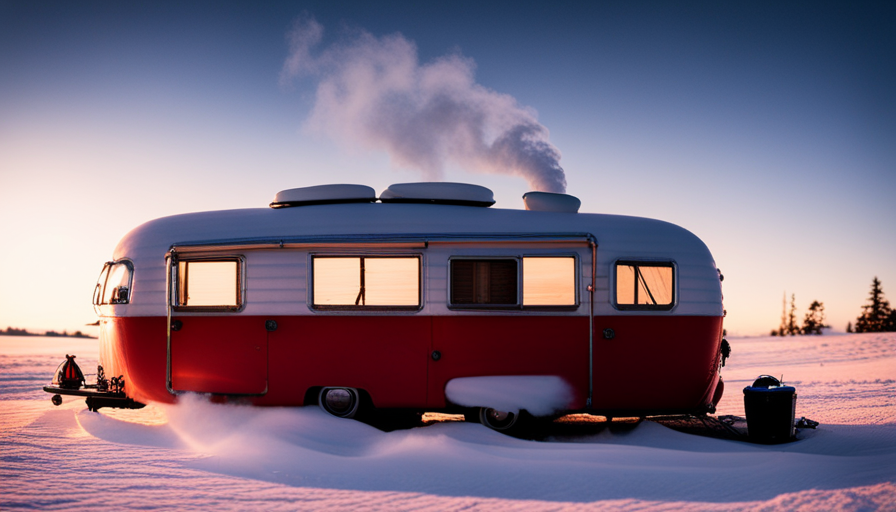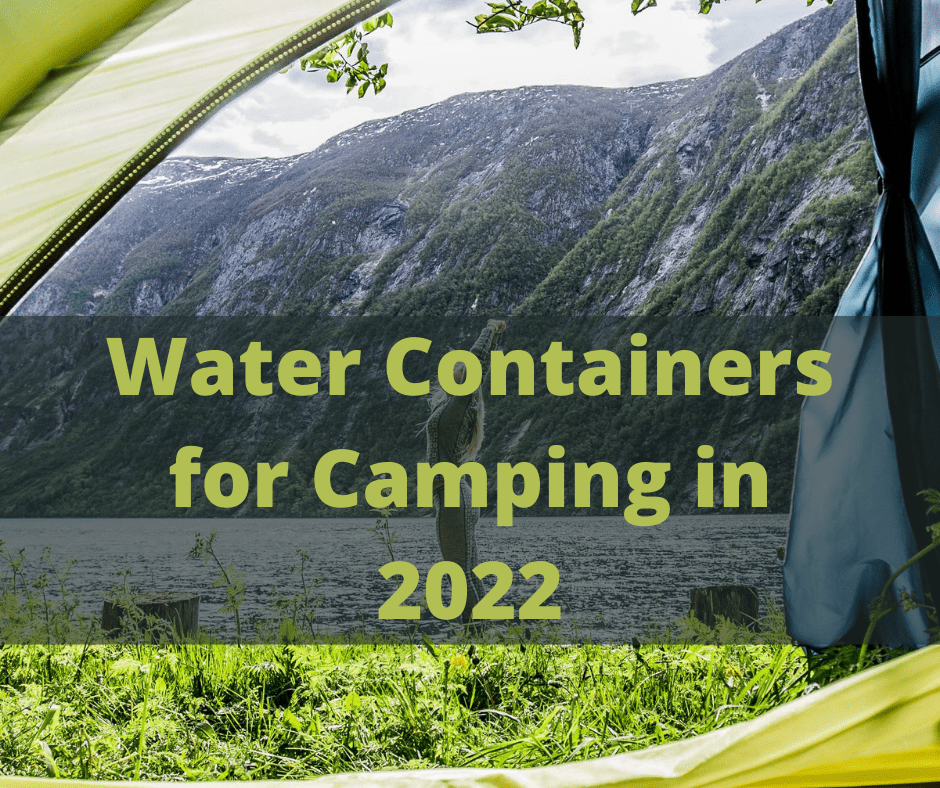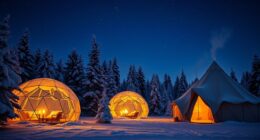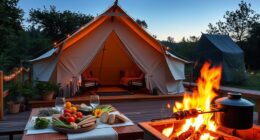Living in a camper during the winter may seem daunting, but with the right preparation and knowledge, it can actually be a cozy and enjoyable experience. Having experienced both the challenges and joys of winter camper living firsthand, I understand the importance of staying warm and comfortable in freezing temperatures.
In this article, I will share practical tips and techniques that will help you thrive in your camper during the winter months. By juxtaposing the harshness of winter with the warmth and comfort of your camper, you’ll discover how to create a safe and inviting living space.
From insulating your camper and investing in a good heating system, to sealing drafts and protecting your water system from freezing, I will guide you through the necessary steps to ensure a cozy winter living experience.
Additionally, I will provide advice on staying active, practicing safe driving techniques, and cooking warm and satisfying meals. With these tips in your arsenal, you’ll be well-equipped to embrace winter living in your camper with confidence and ease.
Key Takeaways
- Proper insulation is crucial for keeping warm air in and cold air out of the camper.
- Investing in a good heating system, such as propane, diesel, or electric heaters, is essential.
- Sealing drafts and leaks with weatherstripping, caulking, and insulation film helps maintain a warm interior temperature.
- Protecting the water system with antifreeze, heat tape, and insulation prevents freezing.
Insulate Your Camper
To effectively live in a camper during the winter, it’s crucial to properly insulate your vehicle. Camper insulation techniques are essential for keeping the cold air out and the warm air in. There are several insulating materials you can use to achieve this.
One option is to use foam board insulation, which is lightweight and easy to install. It provides excellent thermal insulation and helps to reduce condensation inside the camper.
Another option is to use reflective insulation, which is a thin, reflective material that helps to keep the heat inside the camper. It is often used in conjunction with foam board insulation for maximum insulation.
Additionally, you can insulate your camper by using thermal curtains or window insulation film. These help to prevent heat loss through the windows, which can be a major source of cold air infiltration.
By properly insulating your camper, you can create a cozy living space that is warm and comfortable even in the coldest winter weather.
Now that you have insulated your camper, the next step is to invest in a good heating system. This will ensure that you stay warm and comfortable throughout the winter months.
Invest in a Good Heating System
Investing in a good heating system is essential for ensuring a comfortable and cozy living experience in your camper during the colder months. When it comes to choosing a heating system for your camper, there are several energy-efficient options available. One popular choice is a propane heater, which is not only efficient but also easy to use. Another option is a diesel heater, which can be more cost-effective in the long run. Additionally, electric heaters can be a convenient choice if you have access to electricity at your campsite.
To help you make an informed decision, I have created a table that compares these three heating options based on factors like cost, efficiency, and ease of use.
| Heating Option | Cost | Efficiency | Ease of Use |
|---|---|---|---|
| Propane Heater | $$$ | High | Easy |
| Diesel Heater | $$ | Medium | Moderate |
| Electric Heater | $ | Low | Easy |
While investing in a good heating system is important, it’s also worth considering alternative heating methods to supplement your main heating system. Some options include using a portable electric blanket, heated mattress pad, or even a hot water bottle. These alternatives can help keep you warm without relying solely on your main heating system.
Next, let’s explore how to seal any drafts or leaks in your camper to further enhance its insulation and maintain a comfortable living environment during winter.
Seal Any Drafts or Leaks
Ensuring a cozy and comfortable environment in your camper during colder months can be achieved by sealing any drafts or leaks that may compromise its insulation. Proper sealing techniques are essential for preventing heat loss and maintaining a warm interior temperature. Here are three effective ways to seal your camper and keep the cold air out:
-
Weatherstripping: Apply weatherstripping around doors and windows to create a tight seal. This can be done using adhesive-backed foam tape or rubber weatherstripping strips. Make sure to measure the gaps accurately and cut the weatherstripping to the appropriate length.
-
Caulking: Inspect the exterior of your camper for any cracks or gaps and seal them with caulk. Pay close attention to areas where different materials meet, such as around vents, seams, and corners. Use a high-quality exterior-grade caulk that’s suitable for your camper’s specific materials.
-
Insulation film: Apply insulation film to the inside of windows to create an additional barrier against drafts. This transparent film is easy to install and can significantly reduce heat loss through glass surfaces.
By implementing these sealing techniques, you can prevent cold air from entering your camper and ensure a warmer living space.
In the next section, we’ll discuss how to use skirting to protect the bottom of your camper and further enhance its insulation.
Use Skirting to Protect the Bottom of Your Camper
Create a barrier around the underside of your vehicle using skirting to shield it from the elements and improve insulation. Skirting installation is an essential step in preparing your camper for winter living. It involves attaching a material, such as plywood or insulated panels, to the bottom of your camper to create a protective barrier.
This barrier not only prevents cold air from entering underneath your camper but also helps to keep out moisture and pests. When installing skirting, make sure to leave some ventilation openings to allow for proper airflow and prevent condensation buildup. It’s also important to regularly inspect and maintain your skirting throughout the winter season.
Check for any gaps or damage and promptly repair or replace any worn-out sections. Proper skirting maintenance involves cleaning the skirting regularly to remove any debris or buildup. This will help prolong its lifespan and ensure that it continues to effectively insulate your camper. Additionally, consider adding insulation material, such as foam board, between the skirting and the underside of your camper for added protection against the cold.
By installing skirting and properly maintaining it, you can create a barrier that protects the bottom of your camper from the harsh winter conditions. This will help keep your camper warmer and ensure that you can enjoy comfortable living throughout the winter months.
Now, let’s move on to the next section and learn how to keep your water system from freezing.
Keep Your Water System from Freezing
To avoid dealing with frozen pipes, it’s crucial to take steps to protect your water system while camping in colder temperatures. Here are three effective ways to prevent freezing:
-
Use antifreeze in your water system: Before winter camping, make sure to flush out the existing water in your system and replace it with a proper antifreeze solution. This will prevent the water from freezing and damaging your pipes.
-
Install heat tape on exposed pipes: Heat tape is a great investment to keep your pipes warm and prevent freezing. It’s easy to install and works by providing a constant source of heat to the pipes. Simply wrap the heat tape around the exposed areas and plug it into a power source.
-
Insulate your pipes and tanks: Insulation is key to keeping your water system from freezing. Use foam pipe insulation or heat-resistant sleeves to cover exposed pipes. Additionally, insulate your water tanks with insulation blankets or foam boards to retain heat.
By following these steps, you can ensure that your water system remains functional and free from freezing during winter camping.
Now, let’s discuss the next important aspect of living in a camper in the winter: stocking up on warm clothing and bedding.
Stock Up on Warm Clothing and Bedding
Now that we’ve taken measures to keep our water system from freezing in our camper during the winter, it’s time to focus on staying warm ourselves. As the temperature drops, it’s crucial to stock up on winter clothing and bedding to ensure our comfort and safety.
Investing in proper winter clothing is essential when living in a camper during the colder months. Layering is the key to staying warm, so make sure to have thermal underwear, thick socks, and insulated boots. Don’t forget a warm hat, gloves, and a cozy winter coat to keep your extremities protected from the biting cold.
Equally important is having the right bedding to keep you snug and warm during those chilly nights. Opt for flannel sheets and a thick, insulating comforter or duvet. Consider adding an extra blanket or two for added warmth. And don’t underestimate the power of a good hot water bottle or an electric blanket to keep you toasty while you sleep.
By stocking up on winter clothing and bedding, you’ll be well-prepared to face the cold temperatures while living in a camper.
In the next section, we’ll explore how to safely use space heaters to further enhance our comfort and warmth.
Use Space Heaters Safely
Using space heaters in a confined space can be like summoning a miniature sun to warm your surroundings. When living in a camper during winter, portable heaters become essential for staying cozy. However, it’s crucial to use them safely and efficiently.
Here are some tips to make the most out of your portable heaters:
-
Choose energy-efficient models: Look for heaters with high energy efficiency ratings to minimize power consumption and reduce heating costs.
-
Optimize placement: Place the heater in a central location to evenly distribute warmth throughout the camper. Avoid blocking vents or placing it near flammable materials.
-
Monitor temperature: Use a thermostat or temperature gauge to maintain a comfortable temperature without overheating the space.
-
Ensure proper ventilation: Crack open a window or door slightly to allow fresh air in and prevent carbon monoxide buildup.
-
Use a timer: Set a timer to turn off the heater when you go to bed or leave the camper, saving energy and ensuring safety.
By following these guidelines, you can keep warm and reduce energy consumption while living in a camper during winter.
Transitioning into the next section, let’s explore how to cook warm meals and utilize thermal cookware.
Cook Warm Meals and Use Thermal Cookware
Get ready to savor delicious warm meals and make the most of thermal cookware while staying cozy in your camper during the winter months! When it comes to winter cooking in a camper, thermal cookware is a game-changer. Not only does it retain heat well, but it also cooks food slowly and evenly, making it perfect for soups, stews, and chili.
The benefits of using thermal cookware are twofold: it keeps your meals warm for hours, allowing you to enjoy piping hot food even after a long day of outdoor activities, and it saves energy by reducing the need for constant heating.
To maximize the benefits of thermal cookware, here are some winter cooking tips. Firstly, preheat the thermal pot by filling it with boiling water for a few minutes before adding ingredients. This helps to ensure that the food stays hot for longer. Secondly, consider using ingredients that retain heat, such as root vegetables and grains, to create hearty and warming dishes. Finally, be mindful of the cooking time as thermal cookware can take longer to cook food compared to traditional pots and pans.
As you savor your warm and comforting meals, it’s important to stay active and exercise regularly to keep your body warm during the winter months.
Stay Active and Exercise Regularly
To keep warm and stay energized during the chilly months, it’s crucial to stay active and regularly exercise.
Winter hiking is a fantastic way to stay active while enjoying the beautiful winter scenery. Bundle up in warm layers, wear sturdy boots with good traction, and venture out onto nearby trails. The crisp air and snow-covered landscapes will invigorate your senses and keep you motivated.
If venturing outside is not an option, there are plenty of indoor workouts that can be done in the comfort of your camper. Invest in some basic workout equipment like resistance bands or dumbbells to add variety to your routine. Utilize online workout videos or apps for guidance and motivation. You can also create your own workout circuit using bodyweight exercises such as squats, lunges, and push-ups.
By staying active and exercising regularly, not only will you keep your body warm, but you’ll also boost your mood and energy levels. So lace up your hiking boots or grab your workout gear and get moving!
When it comes to living in a camper during winter, it’s important to not only stay active but also practice safe winter driving and parking techniques.
Practice Safe Winter Driving and Parking Techniques
Bundle up in layers of warmth and conquer the icy roads of winter like a fearless explorer, navigating the treacherous terrain with caution and confidence. When living in a camper during the winter, safe driving and parking techniques are essential to ensure your safety and the longevity of your vehicle.
First and foremost, it’s crucial to equip your camper with winter tires. These tires provide better traction on snow and ice, reducing the risk of skidding or getting stuck. Additionally, make sure to check your tire pressure regularly, as cold temperatures can cause it to drop.
When driving in winter conditions, always reduce your speed and increase your following distance. This will give you more time to react to potential hazards and prevent accidents. Be mindful of black ice, which is often invisible and extremely slippery. Keep a firm grip on the steering wheel and avoid sudden maneuvers that could cause your camper to lose control.
Parking safely during winter is just as important as driving safely. Choose a level and well-lit parking spot whenever possible. Clear any snow or ice from your camper’s roof, windows, and mirrors before hitting the road. This will improve visibility and prevent accidents caused by falling ice or impaired vision.
By following these winter driving tips and parking safety precautions, you can confidently navigate the winter roads in your camper. Stay safe and enjoy the beauty of the season!
Frequently Asked Questions
How can I prevent condensation inside my camper during winter?
To prevent condensation inside my camper during winter, I focus on insulating it properly. I use foam insulation on the walls, ceiling, and floor to minimize heat transfer.
I also add weatherstripping to windows and doors to seal any gaps.
Additionally, I use a dehumidifier to remove excess moisture from the air.
By taking these measures, I can maintain a comfortable and condensation-free living environment in my camper during the winter months.
What are some tips for conserving propane while heating my camper in the winter?
To conserve propane while heating my camper in the winter, I use insulation tips and consider alternative heating options.
First, I ensure that all windows and doors are properly sealed to prevent heat loss. I also use insulating curtains and rugs to retain warmth.
Additionally, I use a portable electric heater or a catalytic propane heater as alternative heating sources. These measures help me reduce propane usage and stay comfortable during the winter months.
Are there any specific maintenance tasks I should perform on my camper before winter?
Before winter, it’s important to perform some maintenance tasks on your camper to ensure it’s ready for the cold weather.
First, check the insulation to make sure it’s in good condition and add additional insulation if needed.
Inspect all seals and windows for any gaps or leaks that may let cold air in.
It’s also a good idea to have your furnace and water heater serviced to ensure they’re functioning properly.
Taking these steps will help keep your winter camper cozy and comfortable.
How do I protect my camper’s plumbing system from freezing during winter?
To protect my camper’s plumbing system from freezing during winter, I take a few crucial steps. First, I insulate all exposed pipes with foam or heat tape to keep them warm.
I also drain the water tanks and lines when not in use to prevent ice buildup.
Additionally, I use a space heater or electric blanket to keep the interior temperature cozy. By taking these precautions, I can ensure a comfortable and worry-free winter camping experience while staying warm.
Are there any safety precautions I should take when using space heaters in my camper during winter?
When using space heaters in my camper during winter, it’s important to take safety precautions. First and foremost, ensure proper ventilation to prevent a buildup of carbon monoxide. Keep the heater at a safe distance from flammable objects and never leave it unattended. It’s also crucial to use a heater with a built-in safety feature that automatically shuts off if it tips over. Don’t forget to check the heater regularly for any signs of damage or malfunction.
What Are Some Tips for Keeping Warm in a Camper During the Winter?
To keep your camper warm during winter, start by insulating the windows with thermal curtains or window film. Use draft stoppers on doors and seal any gaps with weatherstripping. Invest in a space heater designed for RV use and position it close to where you spend most of your time. Consider using electric blankets or heated mattress pads for extra comfort. Lastly, dress in layers and cozy blankets to trap heat efficiently. Keep camper warm winter with these simple tips.
Conclusion
In conclusion, living in a camper during the winter can be a challenging but rewarding experience. By insulating your camper, investing in a good heating system, and sealing drafts or leaks, you can stay warm and comfortable.
Using skirting to protect the bottom of your camper and keeping your water system from freezing are essential for survival. Remember to use space heaters safely, cook warm meals, and stay active to keep the cold at bay.
Lastly, practice safe winter driving and parking techniques to ensure a smooth journey. As the saying goes, "There’s no such thing as bad weather, only unsuitable clothing." So bundle up, stay prepared, and embrace the winter adventure in your camper!










